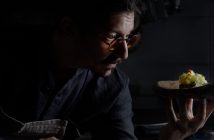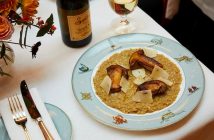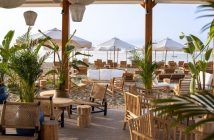Lunch was booked for one o’clock at Combal.Zero in the Museo d’Arte Contemporanea in Rivoli, a small village outside Turin. As I approached the entrance and rang the bell I was unequivocally on time.
Combal.Zero had only re-opened two days previously, after the summer sojourn (apparently it lasts longer in Italy), and perhaps word hadn’t yet caught on, as I was the only diner, at least for the first hour. Later, a wealthy and entirely annoying retired Australian couple entered, who, like giggling first-daters, boisterously put the maître d’, named Luca, through his paces.
Luca is intelligent, bilingual and has paced the shiny floors of many great restaurants: The Ritz (London), Per Se (New York) and Relais La Suvera (Tuscany), finally returning home to Rivoli having spent his childhood only a few minutes away.
The prim, simplistically styled room has a Feng Shui feel with cooling patent colours, tall bamboo and green foliage. There’s the odd contemporary twist, notably three glass balls in the centre of the room resting on three obelisk-style stands. There’s also an eye-catching print on the far wall of a donkey in a boat.
From the restaurant you can look across the Lego houses of Rivoli, their red, chalky slate roofs and the small clusters of trees like fallen clouds. On your left, a tall and attenuate church steeple pierces the sky, crumbling over time. You can see directly through the broken windows, revealing more of the rustic and medieval village. A small crucifix stands firm at its peak.
It’s the most beautiful restaurant setting I’ve ever witnessed. Spectacular views have me transfixed before I’ve even seen the menu.
There are 35 options including one page dedicated to ‘Specials’, the favourites of previous guests who would tear down the walls of Rivoli had they not been included. Each is noted with a vintage year as if a bottle of wine. There is, of course, the famed dish ‘Elio Campari,’ involving a helium balloon.
My Entrate had a wistful nod to my roots: ‘Ganache di cavolfiore, brodo di Stilton e funghi finferli’, the warm Stilton sauce arriving separately in a sliver saucer ready to be poured around the base of the creamy cauliflower dome. Resting on top were handpicked mushrooms that had a nutty, woody texture. It’s a rich dish but not heavy. Diminutive in size, it’s hoisted by the lavishness of complex textures, the Stilton emanation rising through. Perhaps this was the very bouquet that captivated G. K. Chesterton? “Stilton, thou shouldst be living at this hour/And so thou art. Nor losest grace thereby…”
To accompany I had a glass of Bianco Secco ’05 from the Veneto region. It’s a delicious and cooling wine, a medium bodied white with melon and citrus tones. Chilled and expressive.
This was followed by ‘Pasta e minestre’ – my post-starter, yet pre-main course – named: ‘Giro del Mondo in Cinque Minestre’, translated as ‘Around the World in Five Soups’. This was a well thought-out dish. There’s extensive knowledge required of the continents, and of the ingredients needed to represent each. It arrived with five white egg-shaped bowls, each sitting next to one another to complete a charming circle. Each bowl was representative of at least one of the seven continents:
Europa: pata, pomodoro, cipolla di tropea, basilico.
Americhe: carota, zafferano, curry, cocco, fagiolo neri.
Est: (bortsch), panna acida, tartufo nero.
Africa: (matoke), platano, cipolle, coriandolo, peperoncino, Yassa.
Sud est Asiatico: udon, dashi, tofu, euoki, verdure, polline.
I had to make sure I took on water between each soup as mixing such a vast number of ingredients and spices presents some conflicting textures in the mouth. That said, it’s crafted very well, each with real depth of flavour and evoking a sense of each of the represented destinations.
Yassa is a ground powder – popular across West Africa – that really lifted the taste and made the African soup my favourite of the five. It’s also a secret written code of law created by Genghis Khan (probably not worth knowing, but interesting nevertheless). Asia was represented valiantly by its delegates: udon noodle and tofu were rather bland commodities compared with the other soups, resulting in a watery content, unable to stand up against the might of the curry, cocco, panna acida and Yassa.
Finally to ‘Carni e Pesci’, the halfway mark: ‘Filetto di “fassona” impanata alla torinese’. Fassona is a cow from the Piedmont region and is slowly becoming more fashionable in the UK. Piedmont is famous for its Barolo and Barbaresco, made from the Nebbiolo grape. I sipped a lovely Zero Solfiti Langhe Rosso ’07. The wine has a rather intense aroma and a nose of berries and dried fruits. The meat was medium-rare and cut generously into thick cubes covered with a breadcrumb crust. Easy to cut and as soft as a breeze, it was wholesome and worthy of praise.
Moving into the concluding stages of lunch, a strawberry-based sorbet was made from crushed strawberry ice with a dab of cream and a mint leaf – a petite dish with a cooling sweetness. This was followed by one of the very best things I’ve ever tasted: ‘Maccheroni soufflé, zappa di Gelato alle Noci Pecan caramellate, afrancio’; a light soufflé with a seriously sexy sweetness and mild nutty texture from the macaroons. Its creamy moat of caramelised pecan was a soft boost passionately mixed with the soufflé. This was a dessert from the great unknown. Harmony in the mouth. Viagra on a plate.
Afterwards I sat with Davide in his kitchen to discuss his preparation for the seasonal menu and to find out how he conceives such flamboyant and exquisite dishes. He has a knowing presence, his smart, grey hair flicked back like a musketeer. He smokes and we talk over an espresso.
Each new menu is tested and decided upon at least a year in advance. Davide keeps a personal and small team of 12 in the kitchen. All are assigned their duties and Davide oversees a tight ship. He is an energetic worker: crafting new seasonal menus, exhibiting across the world, and last year asked by Louis Vuitton to create a “surrealistic” dinner for the opening of a new store in Düsseldorf – such is Davide’s reputation and global recognition.
There’s no doubt that Davide Scabin is riding a wave of creative success and Combal.Zero is fully deserving of its two-Michelin stars. This year it moved up seven places in The World’s 50 Best Restaurant Awards to number 28, the second highest placed Italian restaurant, and rightly so. Get there quick and try modern twists on classical Italian dishes.
Combal.Zero, Piazza Mafalda di Savoia, 10098 Rivoli, Piemonte, Italy. Tel. +39 0119 565 225. Website.




